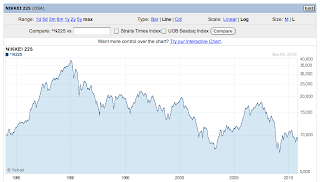As we all know, this week, Federal Reserve Chairman Ben Bernanke announced that the Fed was going to undertake the second part of its quantitative easing program also known as QE2.
The Fed plans to purchase $600 billion worth of United States Treasuries in a "hail Mary", last ditch effort to stimulate the rather sad American economy. One of the side effects of QE2 that Mr. Bernanke is hoping for is a rise in the stock market because of increased demand for shares of all types. After all, that $600 billion has to create a bubble somewhere! This rise in the market will result in the creation of a "wealth effect"; the market is up so consumers will feel wealthier and will spend more (getting themselves back into even more debt which created the problem in the first place).
As I noted in my last posting, Japan and the Bank of Japan have had a program of QE since 2001. I noted that despite their best efforts, the BOJ has not managed to beat deflation, push down the value of the yen or push interest rates back up to normal levels. Here is another thing that they have not managed to do; push up the value of shares on the Nikkei 225, the country’s main stock market.
Here is a chart of the market since the mid-1980s:
You can see that the market reached a peak of 38,957 on December 29th, 1989 before beginning a long downward slope to between 15,000 and 20,000 during the 1990s. In 2001, the BOJ began its own quantitative easing experiment. At that time, the Nikkei was at the 15,000 level. Since then, despite the best efforts of Japan’s central bank, the Nikkei has been a rather pathetic performer; twice reaching levels of 8,000 and, today, is trading at the 9,600 level. This is a 36 percent haircut from its level when the QE experiment commenced and a 75 percent shaving from its peak.
Yesterday (November 4th, 2010), analysts at the major business media outlets were salivating at the rather strong positive response that markets around the world had to Wednesday’s QE2 announcement. They were all pumped up about the return to "getting rich by buying and holding" and that the markets had nowhere to go but up, up, up.
I’d suggest that, yet again, the experience of Japan may prove to be a rather sobering one should Mr. Bernanke’s QE2 experiment fail as I suspect it will.
Click HERE to view more.
You can publish this article on your website as long as you provide a link back to this page.


Be the first to comment